NIST Expands Database That Helps Identify Unknown Compounds in Milk
Got milk? Most people have seen the famous ads featuring celebrities that highlight the importance of drinking milk for building strong bones. Research shows that milk has other benefits, especially for babies, such as helping them grow and strengthening their immune systems. But scientists still don’t understand exactly how milk does these things.
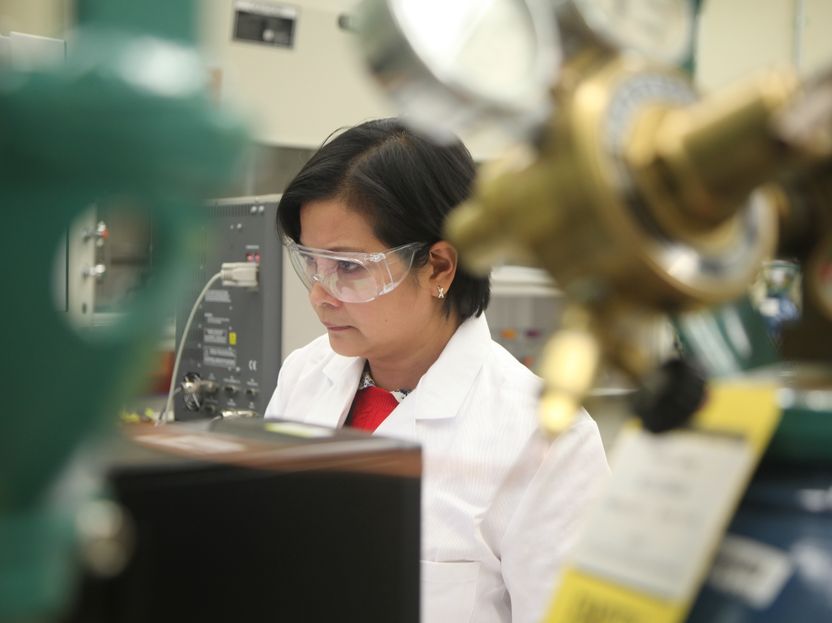
Remoroza operates a mass spectrometer, a laboratory instrument used to identify chemical compounds. “We want to find out as many details as we can about milk because it is so important, but so little is known about its chemistry,” Remoroza said.
R. Press/NIST
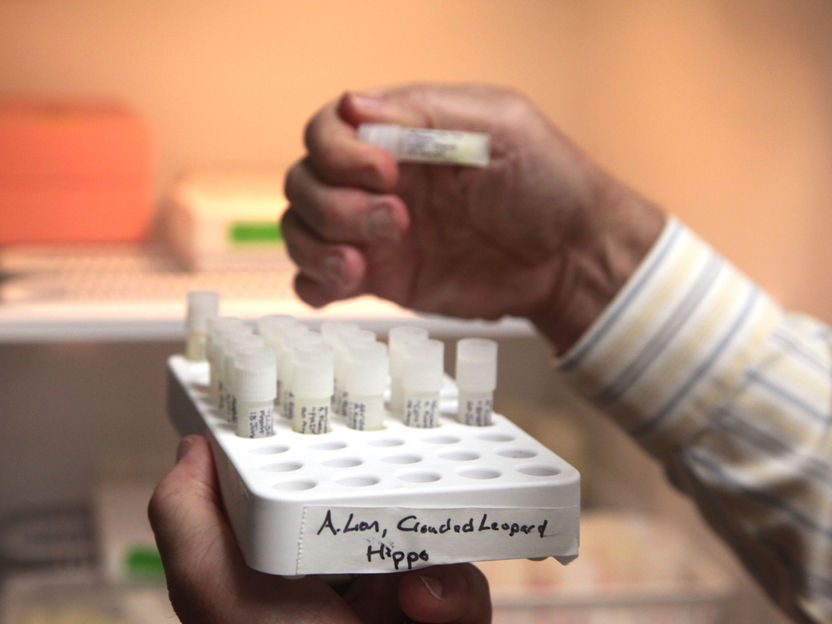
Michael Power retrieves a sample of African Lion’s milk from a freezer. Remoroza will bring the sample back to the lab at NIST, where she will identify the multitude of complex sugars, called oligosaccharides, present in the milk. These sugars have a more complicated molecular structure than the simple sugars found in most foods, and they do more than provide calories. Some play a role in immunity while others promote brain development.
R. Press/NIST
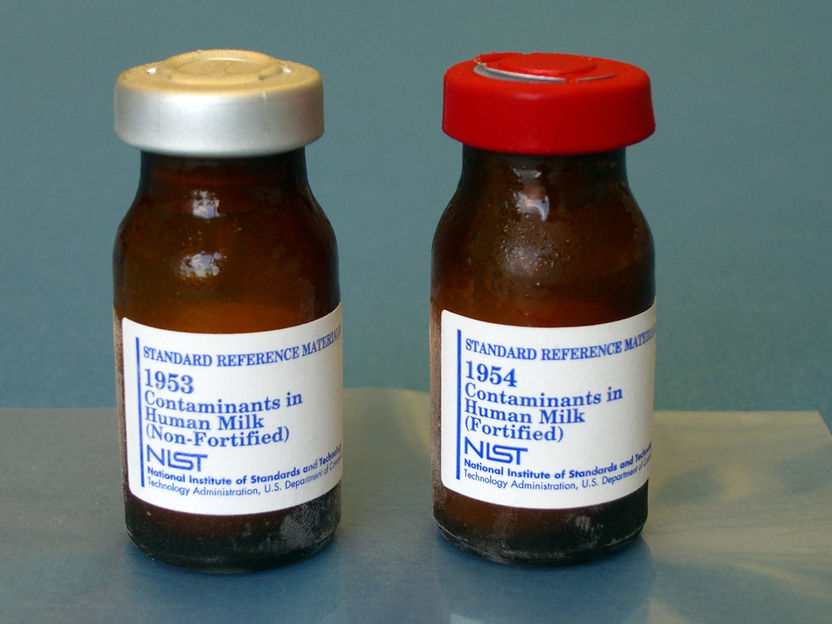
The new NIST Standard Reference Materials for organic contaminants in human body fluids reflect changes in contaminant levels since the last materials were issued in 2000 levels of PCBs, pesticides, dioxins/furans and other contaminants have decreased by 50 percent while the levels of brominated flame retardants have been on the rise. CSTL, SRM, human milk, contaminant, blood, CDC
NIST

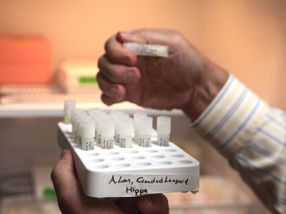
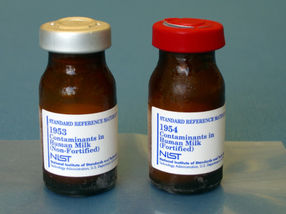
Solving that mystery starts with identifying the compounds in milk. To support that effort, researchers at the National Institute of Standards and Technology (NIST) have recently doubled the size of a reference library that includes examples of a certain type of carbohydrate found in milk from humans and several other animals. The expansion of the library will help scientists identify the unknown compounds in their own milk samples. The researchers published their new findings in Analytical Chemistry
The composition of milk varies from mother to mother, but in general human milk contains 87% water and 13% nutrients, including fats, proteins and carbohydrates. Milk researchers often focus on a type of carbohydrate called oligosaccharides, one of the many different sugars in milk. These sugars are known to have a biological effect, such as providing energy for growing babies or contributing to organ development.
“Babies cannot chew or swallow solid food, so they are highly dependent on milk for growth. It’s a miracle compound,” said NIST chemist Connie Remoroza.
One of the main reasons why scientists analyze oligosaccharides is because if they can determine what oligosaccharides are present, they can begin to understand how oligosaccharides affect cells, tissues and biological processes.
The first version of the human milk oligosaccharide (HMO) library, released in 2018, consisted of 74 oligosaccharides. To build it, Remoroza and her colleagues analyzed components in a milk sample from NIST Standard Reference Material (SRM) 1953. They used a process called liquid chromatography to separate the sample into its finer components and an instrument called a mass spectrometer to create chemical fingerprints known as mass spectra.
Michael Power retrieves a sample of African Lion's milk from a freezer. Remoroza will bring the sample back to the lab at NIST, where she will identify the multitude of complex sugars, called oligosaccharides, present in the milk. These sugars have a more complicated molecular structure than the simple sugars found in most foods, and they do more than provide calories. Some play a role in immunity while others promote brain development.
The team then compared those unknown spectra against a massive database of 1.3 million spectra of 31,000 compounds called the NIST Tandem Mass Spectral Library. It’s part of the larger NIST Mass Spectral Library, which was updated recently in a new version called NIST20.
The team identified an additional 80 new oligosaccharides, bringing the total to 154. The new HMO library also used milk samples from SRM 1954, Organic Contaminants in Fortified Human Milk.
Researchers were also able to identify new compounds that had never been reported in milk before, such as one type of oligosaccharide that contained 15 monosaccharide units, which are the building blocks of carbohydrates.
After mass spectrometry and liquid chromatography are used to produce raw data, it’s then processed in order to extract the mass spectra to identify the unknown compounds. “The identification of unknown compounds depends on state-of-the-art methods. Many oligosaccharides are now known because of improved sensitivity of the mass spectrometers, combined with NIST search software,” said Remoroza.
Once the unknown compounds are identified, they are included in the milk library.
Aside from human milk, Remoroza and her colleagues have also expanded the coverage of other types of mammalian milk. They analyzed four different nonhuman samples thanks to collaborations with the Smithsonian’s National Zoo and Conservation Biology Institute and the Philippine Carabao Center.
The Smithsonian provided an African lion sample, and the Philippine Carabao Center provided milk from a Saanen goat and Asian water buffalo. Bovine (cow) milk samples came from NIST’s very own SRMs 1549a and 1849a. The NIST researchers identified 90 oligosaccharides from these samples, 25 of which were also found in human milk.
Prior research has been done on these animal samples, but relatively few oligosaccharides were reported. Thanks to the development of new instruments, better methods for isolating oligosaccharides, and the new HMO library, scientists can now identify more oligosaccharides in their samples.
“Many researchers will hopefully be able to find NIST milk mass spectral library useful for analyzing their samples,” said Remoroza.
This milk library is especially useful to infant formula manufacturers. “Scientists are interested in identifying the oligosaccharides in milk because they want to determine if these can be added to infant formula so babies can now get the essential nutrients,” said Remoroza.
The work isn’t done yet. Researchers at NIST will continue to identify the different types of oligosaccharides in human milk and expand their collection of nonhuman mammalian milk. They’ll soon be analyzing milk from black and white pigs (in collaboration with Mariano Marcos State University in the Philippines), rhesus monkeys (with the University of Wisconsin) and dolphins (with the National Oceanic and Atmospheric Administration, or NOAA).
Original publication
Concepion Africano Remoroza, Yuxue Liang, Tytus D. Mak, Yuri Mirokhin, Sergey L. Sheetlin, Xiaoyu Yang, Joice V. San Andres, Michael L. Power and Stephen E. Stein. Increasing the Coverage of a Mass Spectral Library of Milk Oligosaccharides using a Hybrid-Search-Based Bootstrapping Method and Milks from a Wide Variety of Mammals. Analytical Chemistry.






























































